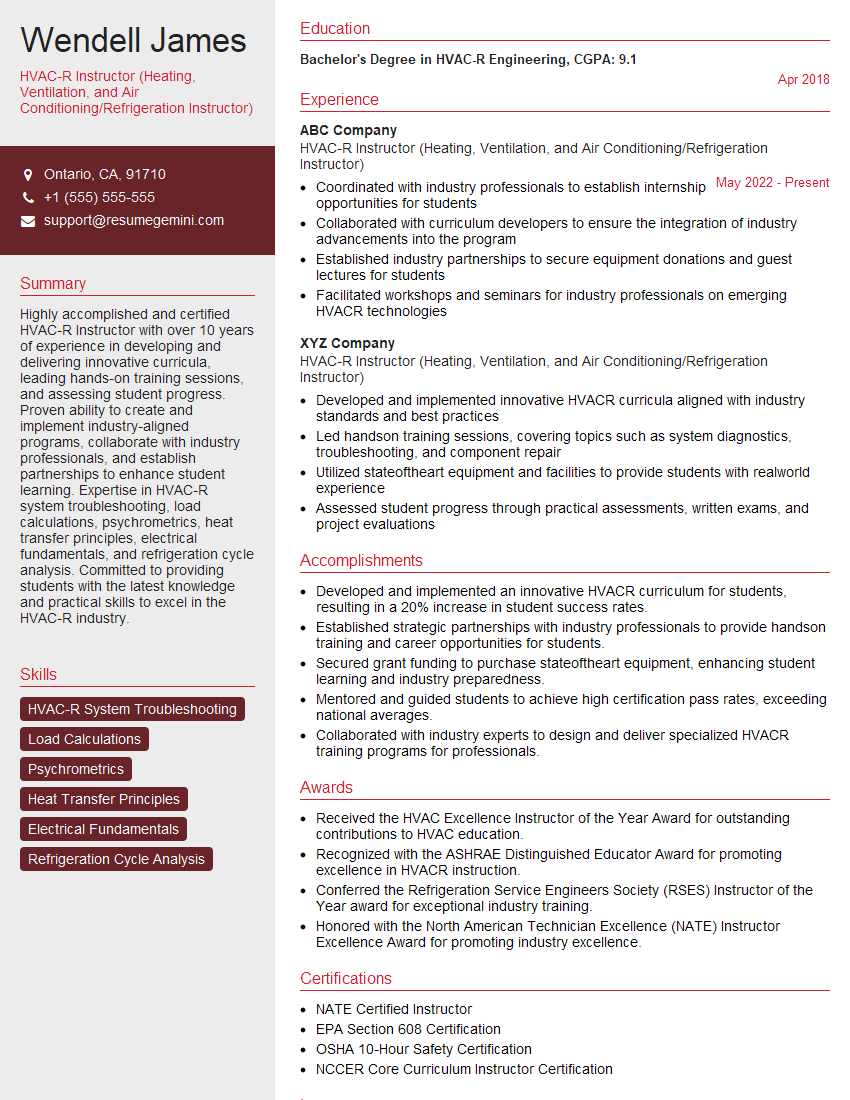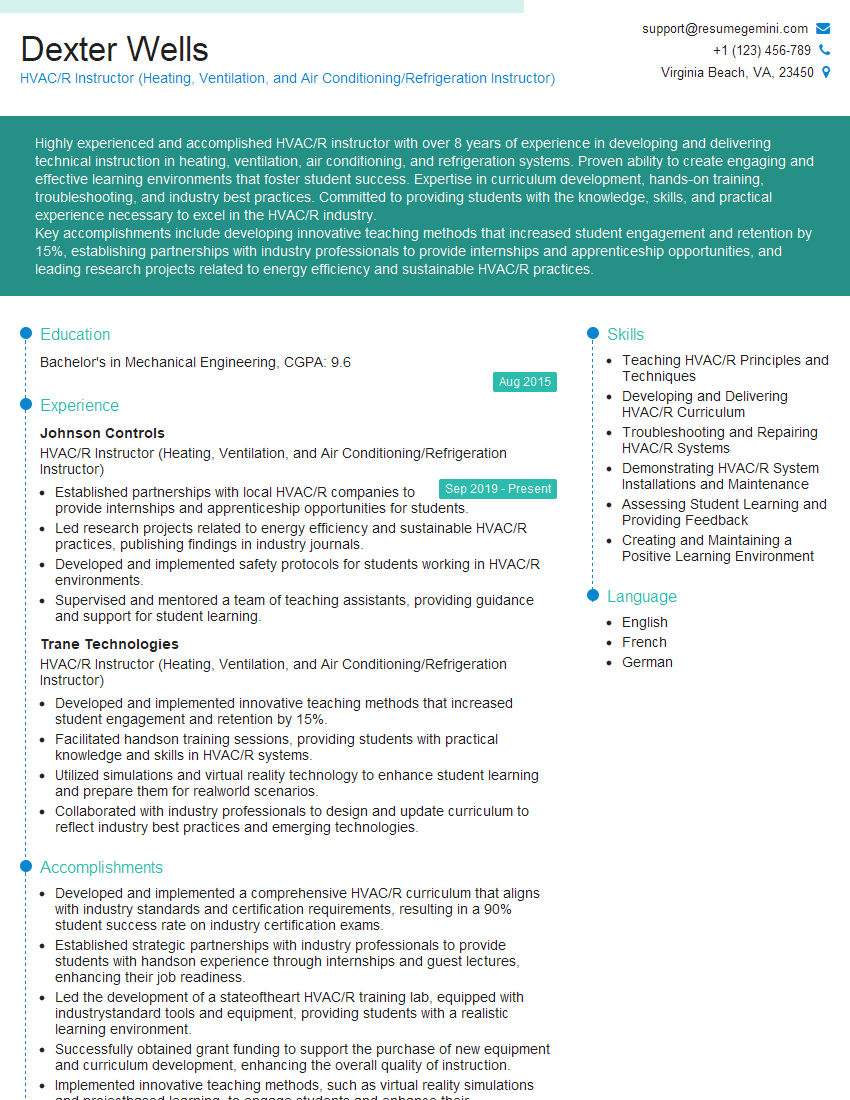Ever felt underprepared for that crucial job interview? Or perhaps you’ve landed the interview but struggled to articulate your skills and experiences effectively? Fear not! We’ve got you covered. In this blog post, we’re diving deep into the HVAC-R Instructor (Heating, Ventilation, and Air Conditioning/Refrigeration Instructor) interview questions that you’re most likely to encounter. But that’s not all. We’ll also provide expert insights into the key responsibilities of a HVAC-R Instructor (Heating, Ventilation, and Air Conditioning/Refrigeration Instructor) so you can tailor your answers to impress potential employers.
Acing the interview is crucial, but landing one requires a compelling resume that gets you noticed. Crafting a professional document that highlights your skills and experience is the first step toward interview success. ResumeGemini can help you build a standout resume that gets you called in for that dream job.
Essential Interview Questions For HVAC-R Instructor (Heating, Ventilation, and Air Conditioning/Refrigeration Instructor)
1. Explain the types of HVAC systems and their applications?
HVAC systems can be classified into different types based on their functionality and applications. The most common types include:
- Single-zone systems: Designed for small spaces or single rooms, these systems provide heating and cooling for a limited area, such as a bedroom or office.
- Multi-zone systems: These systems are used in larger buildings with multiple rooms or zones. They allow for independent temperature control in each zone, providing greater flexibility and energy efficiency.
- Central systems: These systems are designed for large commercial or residential buildings. They distribute conditioned air throughout the building through a network of ducts and vents, providing uniform temperature and humidity control.
2. How do you teach students about electrical components in HVAC systems?
Interactive simulations
- Utilize software and online platforms that provide interactive simulations of electrical circuits and components.
- Students can experiment with different configurations and see the effects in real-time, enhancing their understanding.
Hands-on training
- Provide opportunities for students to work with actual HVAC equipment, such as condensers, compressors, and control boards.
- This allows them to diagnose faults, troubleshoot issues, and gain practical experience.
3. Describe the different types of refrigerants and their environmental impact?
Refrigerants are essential components of refrigeration and air conditioning systems. There are various types of refrigerants, each with its own properties and environmental impact:
- Chlorofluorocarbons (CFCs): Once widely used, but now banned due to their ozone-depleting potential.
- Hydrofluorocarbons (HFCs): Currently used as alternatives to CFCs, but have high global warming potential.
- Hydrochlorofluorocarbons (HCFCs): Transitional refrigerants with lower ozone-depleting potential than CFCs, but still have some environmental impact.
- Natural refrigerants: Such as ammonia, carbon dioxide, and hydrocarbons, have low or zero ozone-depleting and global warming potential.
4. How do you incorporate sustainability into your HVAC instruction?
- Teaching energy efficiency: Emphasize the importance of energy conservation and provide practical tips for reducing energy consumption in HVAC systems.
- Covering green technologies: Introduce students to sustainable HVAC technologies such as geothermal heat pumps, solar thermal systems, and energy recovery ventilators.
5. What methods do you use to assess student learning in HVAC?
- Written exams: Test students’ knowledge of HVAC concepts, principles, and theories.
- Practical assessments: Evaluate students’ ability to perform HVAC tasks, such as installing, troubleshooting, and servicing equipment.
- Projects and assignments: Allow students to apply their learning to real-world situations and demonstrate their problem-solving skills.
6. How do you stay updated with the latest advancements in HVAC technologies?
- Industry conferences: Attend industry events and conferences to learn about new technologies, trends, and best practices.
- Continuing education: Pursue professional development courses and workshops to enhance knowledge and skills.
- Trade publications: Stay informed by reading industry publications, newsletters, and online resources.
7. Describe your teaching philosophy for an HVAC course?
My teaching philosophy revolves around the following principles:
- Hands-on learning: Providing students with ample opportunities for practical application and hands-on experience.
- Real-world relevance: Connecting classroom instruction to real-world applications and industry practices.
- Student engagement: Creating an interactive and engaging learning environment that fosters student participation and critical thinking.
8. How do you create a safe and inclusive learning environment for students from diverse backgrounds?
- Respectful communication: Establishing clear expectations for respectful and inclusive behavior, valuing all students’ perspectives.
- Cultural sensitivity: Acknowledging and incorporating the diverse cultural backgrounds of students into the learning environment.
- Equity and accessibility: Ensuring that all students have access to the same learning opportunities and resources, regardless of their background.
9. Describe your experience in developing and implementing HVAC curriculum?
In my previous role as an HVAC instructor at [Institution Name], I was responsible for developing and implementing a comprehensive HVAC curriculum for the associate degree program. The curriculum covered the following topics:
- HVAC system design and principles
- Electrical components and troubleshooting
- Refrigeration and air conditioning
- Heating and ventilation systems
- Sustainability and energy efficiency
10. How do you evaluate the effectiveness of your teaching?
- Student feedback: Regularly collecting anonymous student feedback on teaching methods, course content, and overall learning experience.
- Assessment results: Analyzing student performance on exams, practical assessments, and projects to measure understanding and skill development.
- Peer observation: Inviting colleagues to observe teaching sessions and provide constructive feedback on instructional practices.
Interviewers often ask about specific skills and experiences. With ResumeGemini‘s customizable templates, you can tailor your resume to showcase the skills most relevant to the position, making a powerful first impression. Also check out Resume Template specially tailored for HVAC-R Instructor (Heating, Ventilation, and Air Conditioning/Refrigeration Instructor).
Career Expert Tips:
- Ace those interviews! Prepare effectively by reviewing the Top 50 Most Common Interview Questions on ResumeGemini.
- Navigate your job search with confidence! Explore a wide range of Career Tips on ResumeGemini. Learn about common challenges and recommendations to overcome them.
- Craft the perfect resume! Master the Art of Resume Writing with ResumeGemini’s guide. Showcase your unique qualifications and achievements effectively.
- Great Savings With New Year Deals and Discounts! In 2025, boost your job search and build your dream resume with ResumeGemini’s ATS optimized templates.
Researching the company and tailoring your answers is essential. Once you have a clear understanding of the HVAC-R Instructor (Heating, Ventilation, and Air Conditioning/Refrigeration Instructor)‘s requirements, you can use ResumeGemini to adjust your resume to perfectly match the job description.
Key Job Responsibilities
HVAC-R Instructors are responsible for developing and delivering training programs in heating, ventilation, air conditioning, and refrigeration (HVAC-R) systems. They work with students to provide them with the knowledge and skills necessary to become successful in the HVAC-R industry.
1. Develop and deliver HVAC-R training programs
Instructors are responsible for developing and delivering training programs that meet the needs of students and industry standards. This includes creating lesson plans, developing teaching materials, and delivering instruction in a variety of formats, such as lectures, demonstrations, and hands-on activities.
- Develop lesson plans and teaching materials that are aligned with industry standards.
- Deliver instruction in a variety of formats, including lectures, demonstrations, and hands-on activities.
2. Assess student learning
Instructors are responsible for assessing student learning and providing feedback to help students improve their performance. This includes developing and administering tests, grading assignments, and providing feedback to students on their progress.
- Develop and administer tests to assess student learning.
- Grade assignments and provide feedback to students on their progress.
3. Maintain a safe and positive learning environment
Instructors are responsible for maintaining a safe and positive learning environment for students. This includes creating a classroom environment that is conducive to learning, enforcing safety regulations, and resolving conflicts between students.
- Create a classroom environment that is conducive to learning.
- Enforce safety regulations.
- Resolve conflicts between students.
4. Stay up-to-date on the latest HVAC-R technologies
Instructors are responsible for staying up-to-date on the latest HVAC-R technologies. This includes attending industry conferences, reading trade publications, and completing professional development courses.
- Attend industry conferences.
- Read trade publications.
- Complete professional development courses.
Interview Tips
1. Research the HVAC-R industry
Before your interview, take some time to research the HVAC-R industry. This will help you understand the industry’s current trends, challenges, and opportunities. You should also research the specific company you are interviewing with to learn about their culture, values, and mission.
- Read trade publications and industry news.
- Visit the websites of HVAC-R companies.
- Attend industry conferences and events.
2. Practice your answers to common interview questions
There are a number of common interview questions that you are likely to be asked, such as “Why are you interested in this position?” and “What are your strengths and weaknesses?” It is important to practice your answers to these questions so that you can deliver them confidently and concisely.
- Prepare a list of common interview questions.
- Practice answering the questions out loud.
- Get feedback from a friend or family member.
3. Dress professionally and arrive on time
First impressions matter, so it is important to dress professionally and arrive on time for your interview. This shows the interviewer that you are serious about the position and that you respect their time.
4. Be yourself and be enthusiastic
The most important thing is to be yourself and to be enthusiastic about the position. The interviewer wants to get to know you and to see if you are a good fit for the company. So relax, be yourself, and let your personality shine through.
- Don’t try to be someone you’re not.
- Be passionate about the HVAC-R industry.
- Show the interviewer that you are excited about the opportunity to work with them.
Next Step:
Armed with this knowledge, you’re now well-equipped to tackle the HVAC-R Instructor (Heating, Ventilation, and Air Conditioning/Refrigeration Instructor) interview with confidence. Remember, preparation is key. So, start crafting your resume, highlighting your relevant skills and experiences. Don’t be afraid to tailor your application to each specific job posting. With the right approach and a bit of practice, you’ll be well on your way to landing your dream job. Build your resume now from scratch or optimize your existing resume with ResumeGemini. Wish you luck in your career journey!

